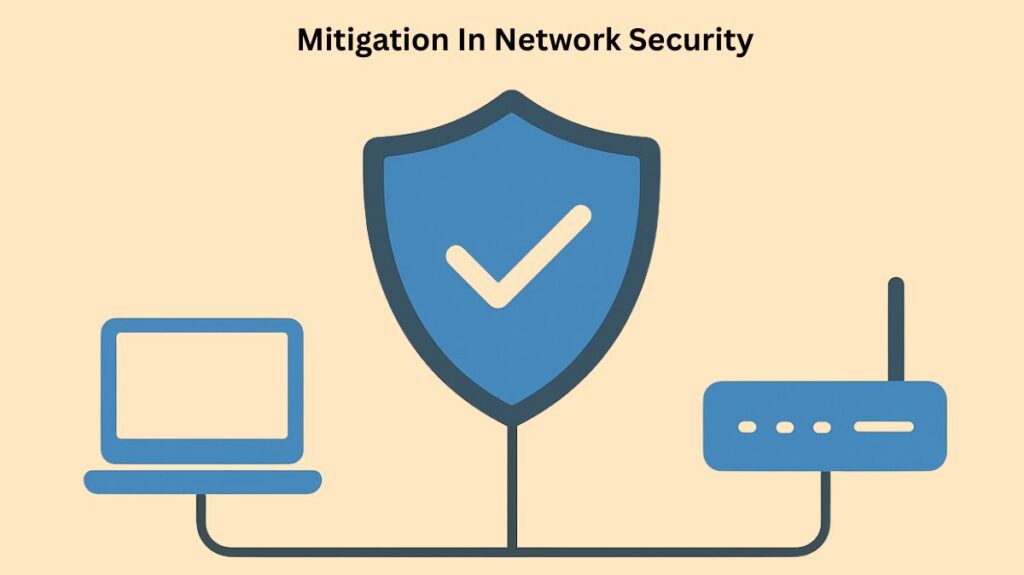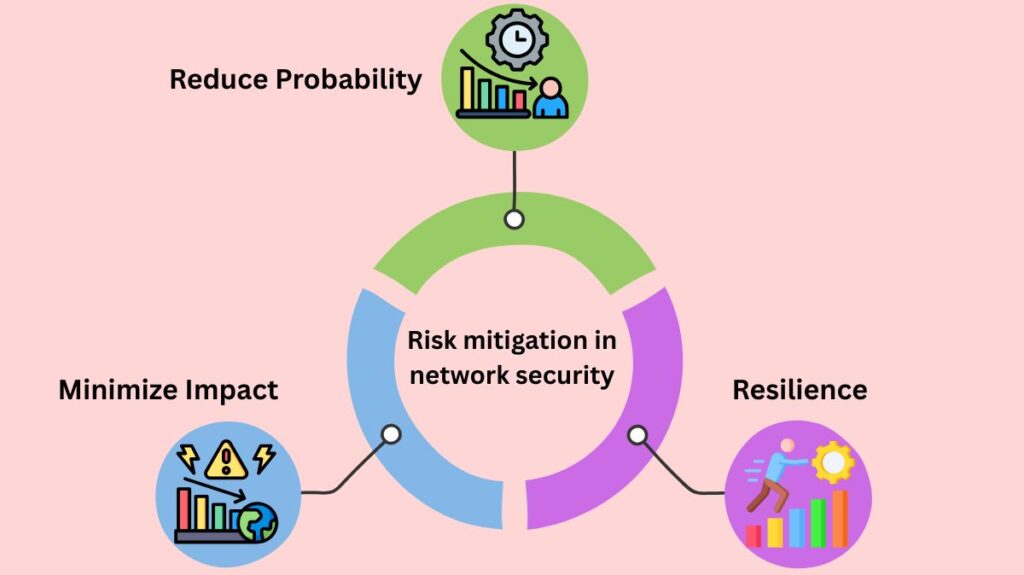What is mitigation in network security?

Attack mitigation is the process of keeping an eye on your system’s weaknesses in order to prevent threats from entering the network. Although it is a desirable practice, security measures should not be confused with it. In ethical hacking, it’s crucial to take necessary precautions to stop attacks before they start. This is known as defence. In the event that your defences fail while you’re implementing mitigation procedures, this will gradually lower the amount of successful attacks without compromising network security. Preventing incidents is equally as important as averting possible attacks. This can be accomplished by determining the weaknesses that could harm your company and taking steps to reduce the risks.
Also Read About What Is Scareware Attack And How Does Scareware Work?
Implementing tactics and resources to lessen the possibility or impact of a cyberattack or other network danger is known as network security mitigation. Mitigation, also known as Defence in Depth, is a comprehensive, multi-layered technique that attempts to prevent or lessen the severity of potential harm.
Techniques for mitigating network security include operational procedures, human factors-focused tactics, and technical measures.
Mitigation techniques in network security
Administrative and Foundational Mitigation Techniques
Organisational policy and human factors are the first steps towards effective mitigation. These measures create the conditions required for strong network defence:
- Procedure and Policy for Security Senior management is in charge of draughting rules that specify acceptable behaviour, including the need for secure passwords, and make reference to the network topology.
- Awareness and Training for Employees Many cyber incidents are the result of human error. Employees who receive regular training are better equipped to recognise and report suspicious activities because they have a better awareness of dangers like phishing and social engineering.
- Risk-Oriented Approach To ensure that significant vulnerabilities are fixed first and to maximise the effectiveness of resource allocation, mitigation efforts should be prioritised according to the amount of risk posed by a possible threat.
- Control of Physical Access A fundamental component of the security program is safeguarding servers, network equipment, and infrastructure (for example, by keeping them in a room with limited access).
- Least Privilege Principle (PoLP) Users should only be given the minimal amount of access required to carry out their duties, as this lowers the possible harm that compromised accounts could cause.
Also Read About SYN Flood Attack And Mechanism Of The SYN Flood Attack
Technical Mitigation Techniques (Detective and Preventive)
Technical controls are intended to detect suspicious activities (Detective) or actively block risks (Preventive).
Preventive Controls (Stop the Attack)
Before a danger can take advantage of a vulnerability, several steps actively impede or discourage it:
- Patch administration and routine software upgrades Applying security patches to operating systems, apps, and firmware on a regular and timely basis resolves known vulnerabilities and stops hackers from taking advantage of out-of-date software.
- By filtering traffic across trustworthy and untrusted networks according to pre-established security standards (such as IP, port, or protocol), firewalls serve as an essential first line of defence. NGFWs, or next-generation firewalls, offer deep packet inspection.
- By requiring users to submit multiple forms of verification in order to log in, Multi-Factor Authentication (MFA) makes it far more difficult for hackers to obtain unauthorised access, even in the event that a password is hacked.
- Segmenting a network If one section of the network is hacked, the attacker’s capacity to travel laterally (spread an attack) is limited, limiting the harm to vital systems.
- The use of encryption Encrypted data must be transferred and stored. Sensitive information is protected by encryption, which renders it unreadable by unauthorised parties while it is in transit (using Virtual Private Networks(VPNs) for remote connections or TLS/SSL for online traffic).
- Systems for Preventing Intrusions (IPS) These are frequently used to stop common Denial-of-Service (DoS) attacks by automatically blocking malicious traffic in real-time when they detect known attack signatures or suspicious activity in the traffic.
- Layer 2 (switches) Access Layer Security Mitigation consists of DHCP Snooping (validating DHCP packets to avoid rogue DHCP servers), Port Security (limiting MAC addresses to mitigate spoofing/flooding attacks), and Dynamic ARP Inspection (DAI) (to mitigate ARP spoofing).
Detective Controls (Find the Intruder)
Security teams are notified of suspected activities by these controls:
- Systems for detecting intrusions (IDS) Just before a possible attack is initiated, the IDS creates an alert based on suspicious network activity.
- Event Management and Security Information (SIEM) a centralized platform that provides real-time threat detection and insight by gathering, combining, and analysing logs and security event data from several sources (firewalls, servers).
- Continuous Audits and Monitoring Early detection and remediation are made possible by the use of solutions for continuous security monitoring, which offer real-time information on the organisational security posture. The efficacy of mitigation measures is confirmed by routine audits.
Responsive and Remedial Controls
In order to contain an ongoing security incident and resume regular operations, the following strategies and activities were implemented:
- An incident response plan (IRP) is a written strategy that specifies the steps and responsibilities involved in anticipating, identifying, containing, eliminating, and recovering from a security breach.
- Plans for Data Backup and Recovery Recovery from damaging cyberthreats like ransomware depends on regular, secure backups of important data. Backups guarantee little loss and downtime when restoring data.
- Keeping things contained preventing the spread of an attack by acting quickly during an occurrence, such as by disabling compromised accounts or isolating impacted network portions.
Also Read About What is a DNS Spoofing Attack or DNS Cache Poisoning
Risk mitigation in network security
In network security, risk mitigation is the process of bringing a security threat’s likelihood or impact down to a manageable level. It entails putting security measures and controls in place to lessen a system’s vulnerability to potential threats.
Core Objectives of Risk Mitigation

The following are the main objectives of mitigation:
- Reduce Probability: Put in place safeguards that lessen the likelihood of a successful attack (e.g., multi-factor authentication, powerful firewalls).
- Minimize Impact (Severity): If a security incident does happen, minimize the harm (e.g., network segmentation, backups).
- Resilience: Ensure business continuity by recovering from an incident as soon as possible and continuing to run critical operations.
Mitigation vs Other Risk Responses
| Risk Response | Definition | Example |
| Mitigation | Taking steps to reduce the risk’s impact or probability. | Applying a firewall rule to block a specific type of attack. |
| Avoidance | Eliminating the activity or system that causes the risk. | Discontinuing an outdated service that has known, severe vulnerabilities. |
| Transference | Shifting the financial impact of the risk to a third party. | Purchasing cyber insurance to cover losses from a data breach. |
| Acceptance | Taking no action, typically because the cost of mitigation outweighs the potential loss. | Accepting the small risk of a non-critical server failing due to high mitigation costs. |
Also Read About How Can You Prevent A BEC Attack And Types Of BEC Attacks
